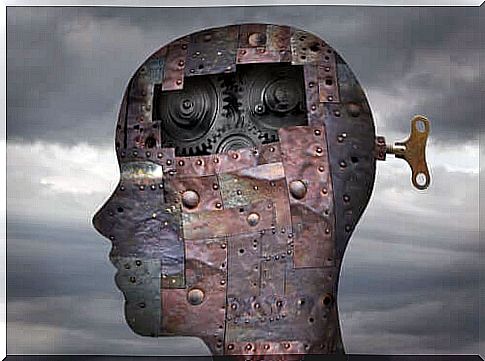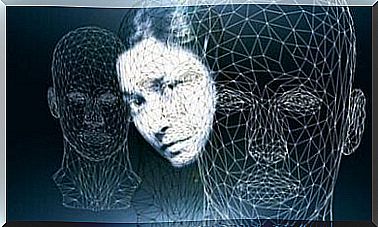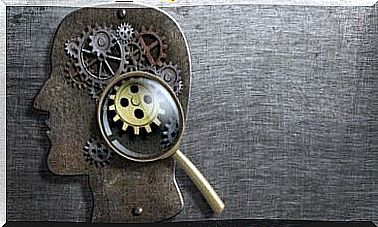Defense Mechanisms Of Neurotics And Psychotics

Defense mechanisms are automatic psychological processes and may be typical of neurotics or psychotics. They protect the individual from anxiety or the perception of internal and external dangers or stressors.
They mediate the individual’s response, avoiding emotional conflict in the face of internal or external stressors.
Although neurosis and psychosis, forms of functioning of the human psyche, often coincide in some characteristics, the mechanisms that command them are different.
The difference is mainly in the relationship with reality and in the way it is constructed. In neurosis fantasy reigns in response to a point of fixation. In psychosis, on the other hand, there is a complete replacement that seeks the restitution of something that was denied in the beginning of life.
Properly neurotic defense mechanisms
Repression
Mechanism by which the Ego prevents anxiety-generating thoughts from reaching consciousness. It is the most basic defense mechanism. For any other to happen, this must happen first.
Transfer
It replaces our true anxiety-producing and intolerable desire for another, non-anxiety-producing and acceptable target. This mechanism can explain why we suddenly feel phobic about something.
For example, if we feel dirty and are ashamed to say it, we express our disgust and phobia by directing it towards cockroaches.

Identification-Based Neurotic Defense Mechanisms
Identification
It is a psychological process that consists in the tendency to increase feelings of personal worth by adopting the characteristics of someone who is admired.
projective identification
Mechanism described by Melanie Klein, which refers to the fantasies through which the subject introduces his own persona or self (totally or partially) inside the object to control it, possess it or cause damage.
Identification with the aggressor
Described by Anna Freud and Ferenczi, it consists of the subject reproducing some characteristic of the person that brings him anguish. The person ceases to be the threatened individual to be the person who threatens.
Projection
Mechanism through which unrecognized characteristics that cause anxiety in another person or object are attributed. This defense is present in psychosis, neurosis and perversion.
introjection
Mechanism described by Ferenczi that consists in attributing to oneself characteristics of others, without being elaborated or adjusted to the self . For example, a depressed person may incorporate another person’s attitudes and thoughts.
The healthy way to do this would be through identification. Identification implies incorporating into your own self desirable things from another person. Introjection would be like “accepting them without digesting them”, resulting in an unintegrated self .
Defense mechanisms based on drive transformation
Reactive Formation
Mechanism by which objectionable thoughts are repressed and then expressed through their opposites. This defense mechanism explains mania, which would hide a repressed depression.
Substitution or substitution formation
Mechanism through which a libidinous object is repressed and replaced by a more acceptable and conscious object. In this way, it is possible to satisfy the forbidden pleasure in a disguised way.
For example, someone who is repulsed by his partner but cannot accept this fact represses that emotion and expresses it in the form of an allergic reaction.
Sublimation
Mechanism that seeks to replace an unacceptable object or activity with one that has a higher social or ethical value.
Rationalization
It consists of the rational justification of thoughts or behaviors that produce anxiety.
It differs from intellectualization because it occupies a different place, not assuming a systematic avoidance of affects, but attributing to them more plausible than true motivations, giving rational or ideal justification.
Intellectualization
The individual tries to give a discursive formulation to his conflicts and emotions in order to control them. It combines the emotional isolation that normally accompanies a painful event with a rational explanation.
Defense mechanisms in which the drive is repressed or masked
Isolation
Mechanism through which an uncomfortable representation is separated from its affect, keeping it at a conscious level, but deprived of any associative connection.
For example, a child who has anxiety about being abused but is unable to see the relationship between the two.
Commitment Formation
It consists of a deformation of the repressed that can manifest itself in three ways: in dreams, in symptoms and in certain artistic productions.
Retroactive annulment/cancellation
According to Freud, it is a consistent active process that seeks to undo what has been done. The individual tries to transform a thought or an act into something that never happened.
The transformation of a drive into its opposite
It consists in transforming the end of a drive into its opposite. The end of the drive that is transformed, not the object through which it is satisfied.
For example, if my partner leaves me, the love I felt for him turns to hate. For the same object that I felt love before, now I feel hate. The drive has been transformed, but the object (my companion) has not.

Properly psychotic defense mechanisms
disclaimer
According to Freud, this mechanism consists of eliminating an uncomfortable representation, not erasing it (annulment), nor refusing to recognize it as belonging to the individual (denial), but denying even the reality of the perception linked to this representation.
Disruption of the Ego
This is a psychotic defense mechanism against dissociation and death anxiety. A part of the Ego gets in touch with the reality that is not disturbing.
The other part of the Ego loses all contact with reality, rejecting all aspects that are very distressing and, if necessary, rebuilding a new reality that is more acceptable and, in turn, more desired through a delusion.
Disruption of the Imago, personal affective fantasy
This is the mechanism of a limit state that fights against the anxiety of losing the object and dissociates uncomfortable representations.
For example, an individual who projects the difficult part of his reality abroad, but without losing contact with it. Dissociation does not imply a loss of contact with reality.
Foreclosure
Foreclosure, a term used by Lacan to refer to exclusion, presupposes the rejection of the primordial signifier in the constitution of the child as an individual differentiated from his mother. This condemns the child not to constitute himself as a subject within the preexisting linguistic universe and predisposes him to psychosis.
Defense mechanisms are divided into different groups that relate to levels of defensive functioning.
Neurotics’ defense mechanisms are articulated as protectors in the face of an untolerated reality, even if a connection with it is achieved at some level.
In psychosis, however, the distressing reality is not tolerated in any way, and the defense mechanisms are articulated, leaving the person in contact only with the desired or imagined reality, without contact with the distressing reality.
In this way, it is possible to gain some stability in the emotions. Sometimes this emotional stability is achieved by building a delusion.









